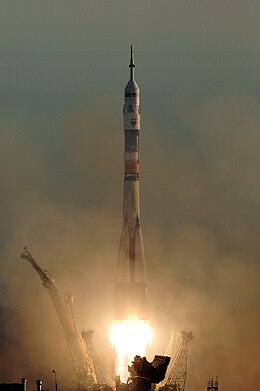Soyuz TMA-8
 | |
| Operator | Roscosmos |
|---|---|
| COSPAR ID | 2006-009A |
| SATCAT no. | 28996 |
| Mission duration | 182 days |
| Spacecraft properties | |
| Spacecraft type | Soyuz-TMA 11F732 |
| Manufacturer | RKK Energia |
| Launch mass | 7,270 kilograms (16,030 lb) |
| Crew | |
| Crew size | 3 |
| Members | Pavel Vinogradov Jeffrey Williams |
| Launching | Marcos Pontes |
| Landing | Anousheh Ansari |
| Callsign | Carat |
| Start of mission | |
| Launch date | March 30, 2006, 02:30 UTC |
| Rocket | Soyuz-FG |
| Launch site | Baikonur 1/5 |
| End of mission | |
| Landing date | September 29, 2006, 01:13 UTC |
| Landing site | Kazakhstan |
| Orbital parameters | |
| Reference system | Geocentric |
| Regime | Low Earth |
| Perigee altitude | 200 kilometres (120 mi) |
| Apogee altitude | 241 kilometres (150 mi) |
| Inclination | 51.67 degrees |
| Period | 88.64 minutes |
| Docking with ISS | |
| Docking port | Zarya nadir |
| Docking date | 1 April 2006 04:19 UTC |
| Undocking date | 28 September 2006 21:53 UTC |
| Time docked | 180d 17h 34m |
| File:Soyuz TMA-8 Patch.png
File:Expedition 12 Soyuz-TMA-8.jpg From left to right: Marcos Pontes, Pavel Vinogradov and Jeffrey Williams. Soyuz programme (Crewed missions) | |
Soyuz TMA-8 was a Soyuz mission to the International Space Station (ISS) launched by a Soyuz FG launch vehicle.
Crew

Soyuz TMA-8 was a transport mission for portions of the International Space Station (ISS) Expedition 13 crew. The flight delivered ISS Commander Pavel Vinogradov and ISS Flight Engineer Jeffrey Williams to the station to replace Expedition 12 crew members. Flight Engineer Marcos Pontes joined the TMA-8 crew for the ascent and docking with ISS, spent approximately seven days aboard the ISS conducting experiments as part of the Missão Centenário, then returned to Earth with the outgoing members of Expedition 12 aboard Soyuz TMA-7. Vinogradov and Williams were joined on their return trip to Earth by Spaceflight Participant Anousheh Ansari who launched aboard Soyuz TMA-9 and spent approximately eight days aboard ISS conducting experiments for the European Space Agency.
| Position | Launching crew | Landing crew |
|---|---|---|
| Commander | Expedition 13 Second spaceflight | |
| Flight Engineer | Expedition 13 Second spaceflight | |
| Spaceflight Participant | Only spaceflight |
Only spaceflight Tourist |
Back-up crew
| Position | Crew | |
|---|---|---|
| Commander | ||
| Flight Engineer | ||
| Flight Engineer | ||
Docking with ISS
- Docked to ISS: April 1, 2006, 04:19 UTC (to nadir port of Zarya)[3]
- Undocked from ISS: September 28, 2006, 21:53 UTC (from nadir port of Zarya)
Mission highlights


29th crewed flight to ISS (Flight 12S)
Soyuz TMA-8 is a Soyuz spacecraft which was launched on March 30, 2006 by a Soyuz-FG rocket from the Baikonur Cosmodrome. Near the end of second stage burn, a communications blackout occurred at Moscow Mission Control. A satellite link was lost, but was restored about 10 minutes later. The crew was safe throughout the loss of communications.
The spacecraft carried two members of the Expedition 13 crew to the International Space Station, together with Marcos Pontes, the first Brazilian in space. The Brazilian government paid Russia approximately $20 million (USD) for Pontes' flight.[4] They replaced the Expedition 12 crew, Commander William McArthur and Valery Ivanovich Tokarev. Together with the Expedition 12 crew, Marcos Pontes returned to Earth on board Soyuz TMA-7.
Soyuz TMA-8 returned to Earth, together with Expedition 13, the spaceflight participant launched with Soyuz TMA-9, Anousheh Ansari.[5]
See also
References
- ^ a b c NASA (2006-03-29). "New Station Crew Launches From Baikonur". National Aeronautics and Space Administration. Retrieved 2007-08-12.
{{cite news}}: Cite has empty unknown parameter:|coauthors=(help) - ^ a b c NASA (2006-01-05). "NASA Announces Next International Space Station Crew". NASA. Retrieved 2007-08-12.
- ^ NASA (2006-03-31). "New Crew Docks With Space Station". NASA. Retrieved 2007-08-12.
{{cite news}}: Cite has empty unknown parameter:|coauthors=(help) - ^ Delphine Thouvenot (2005). "Brazil's President In Moscow Signs Deal For Joint Space Mission". Space Daily. Retrieved October 30, 2007.
- ^ NASA (2005-09-28). "Space Station Crew Back on Earth". NASA. Retrieved 2007-08-12.
{{cite news}}: Cite has empty unknown parameter:|coauthors=(help)


